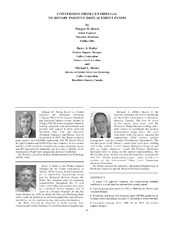| dc.contributor.other | International Pump Users Symposium (26th : 2010) | |
| dc.creator | Bruck, Morg M. | |
| dc.creator | Butler, Barry A. | |
| dc.creator | Moore, Michael L. | |
| dc.date.accessioned | 2017-09-19T21:08:55Z | |
| dc.date.available | 2017-09-19T21:08:55Z | |
| dc.date.issued | 2010 | |
| dc.identifier.uri | https://hdl.handle.net/1969.1/162621 | |
| dc.description | Tutorial | en |
| dc.description.abstract | A major U.S. pipeline company was experiencing multiple problems at a crude pipeline intermediate pump station: Pipeline pumps were rated for 3500 to 7000 bph on 20 cSt crude (original design); Reliability and mean time between repair (MTBR) problems on existing centrifugal pumps because of operating at about 600 bph; Viscosities ranging from 1500 cSt to 5000 cSt (versus original design); The installed pumps also were under a power company restriction of 500 hp maximum (because of inrush current limit at starting conditions); The required flow rates varied from about 425 bph to 800 bph; Because of viscosity correction the centrifugal pump efficiency varied from about 10 to 20 percent when MTBR allowed the pumps installed to run; Pressure management on the pipeline system was not evenly distributed between the stations. The application seemed ideal for a rotary positive displacement (PD) pump. However, there was an additional complication/concern because only a few company personnel had experience with operating positive displacements pumps in series on a “tight-line” operation.The pipeline company’s personnel worked with vendors to select a probable pump. The selected vendor provided several pipeline companies as reference examples of running rotary PD pumps in series across a pipeline system. After observing firsthand the operation of a pipeline system in Canada, the company then used computer simulations to model the hydraulic responses of the pump, controls and pipeline system. Ther computer simulations convinced management that rotary PD pumps would indeed function properly and safely in series with reciprocating PD pumps that were located at the originating pipeline stations (upstream in the system). Additional items that were addressed as a part of the redesign of the station were: Equipment vibration level reduction; Flow-rate flexibility and control system upgrades for the system and redesigned station; Electrical distribution stability for the station. Once installed, the rotary PD pumps provided improved MTBR, better pressure management, and more cost effective operation of the pipeline system in question. The throughput increase averaged 39 percent even though the increased power cost was only 9 percent. The tutorial will show examples of: Operating data showing system flow before and after station redesign; Rotating equipment installation improvements using before and after photos; Operating data showing pressure management improvements; Station operating costs before and after and cost per barrel improvements; Pump testing and inspection to ensure minimal startup issues. | en |
| dc.format.medium | Electronic | en |
| dc.format.mimetype | application/pdf | |
| dc.language.iso | en | |
| dc.publisher | Turbomachinery Laboratory, Texas A&M University | |
| dc.relation.ispartof | Proceedings of the 26th International Pump Users Symposium | en |
| dc.subject.lcsh | Pumping machinery | en |
| dc.title | Conversion Of A Pipeline Station From Centrifugal To Rotary Positive Displacement Pumps | en |
| dc.type.genre | Presentation | en |
| dc.type.material | Text | en |
| dc.identifier.doi | https://doi.org/10.21423/R1HD1F | |


